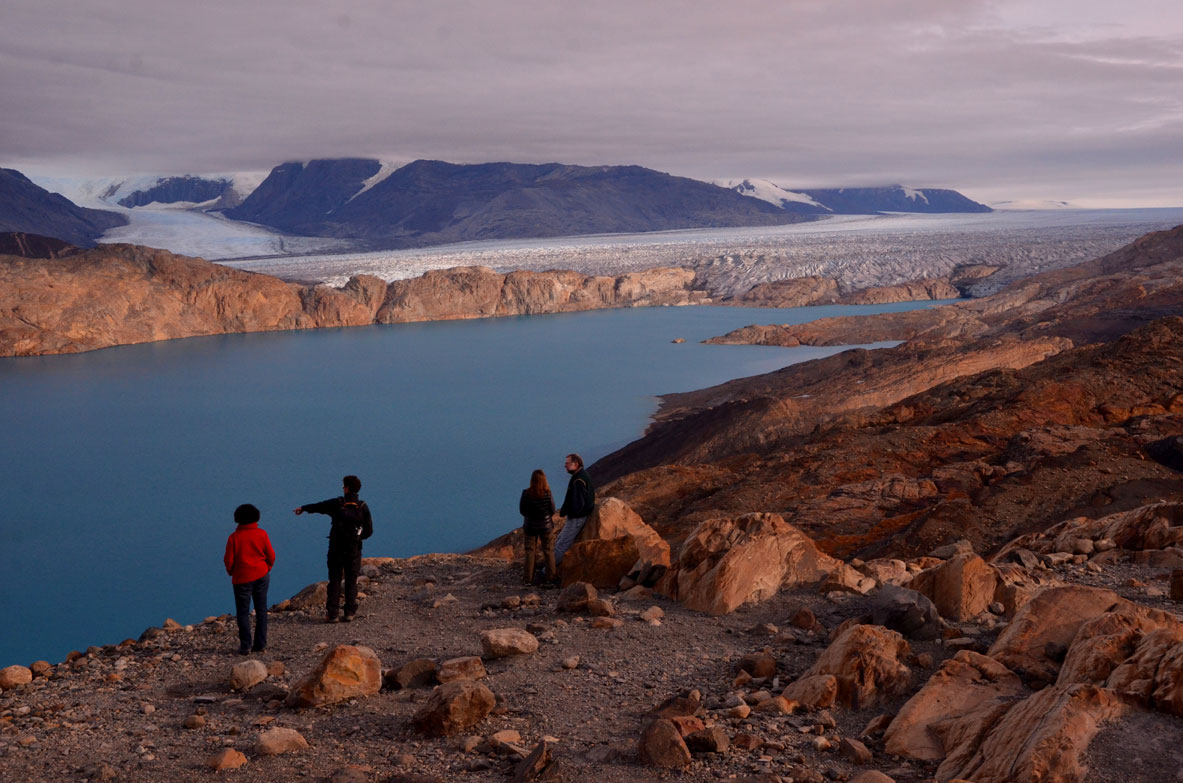ARGENTINA – OVERVIEW & BUENOS AIRES / COLONIA DEL SACRAMENTO, URUGUAY
Argentina is a land of contrasts. Still a frontier destination in the New World, but mostly European in culture. It has one of the lowest population densities in the world, but the capital Buenos Aires has one the highest. It is a land of many glaciers and wide expanses of desert. It is the home of gauchos and many world famous architects. The country has animals as diverse as penguins and elephant seals to guanacos and rheas. Iguazu Falls is one of one of world’s largest and the arid Talampaya Canyon towers almost 500 sheer feet. It has a history of wide spread democracy and military juntas. It has been a land of unbound opportunity for some and a difficult place economically for others. It is the home of the tango and a center for alternative rock in Latin America. The list goes on and on.
The country is immense and the eighth largest in the world. To adequately see just the highlights would take at least two months if one rushed. The usual strategy is to experience a few regions in each trip, which is what my wife Khadija and I chose to do.
We traveled there (with side trips in Chile and Uruguay) from March 16 to April 7, 2017 with our good friends Roger and Nancy. In our three weeks there, we constantly found extremely interesting places while consuming delicious food. Importantly we experienced the country’s contrast, from the empty, windswept Patagonia to the bustling metropolis of Buenos Aires.
Facts
Argentina is over a million square miles, about 1/3 of the continental United States. The population is around 44 million, with about 1/3 living in the Buenos Aires metropolitan area. Over 80% of the population is majority from European descent.
Argentina had an estimated 300,000 inhabitants when the Europeans arrived. As elsewhere in the Americas, they were almost wiped out by disease and war. Today around 2% of the population is Amerindian, most living near the borders of Paraguay, Bolivia and northern Chile. Through DNA analysis, it is estimated around half of Argentines have one indigenous ancestor. In fact, gauchos who live in Argentina’s pampas (provinces touching or close to Uruguay and Brazil) usually have mixed European and Amerindian ancestry. Many consider gauchos as the “original” Argentinians. Of note, the number of Afro-Argentinians is about 150,000.
Argentina is the largest Spanish-speaking nation in the world by area. Many Argentinians speak some English, which greatly assists travelers.
Visa Requirements
Argentina requires no visa for traveling 90 days or less for over 80 countries including US, EU, Australia, and Canadian citizens. Australians and Canadians must first pay a reciprocity fee online and travel with a printed copy of payment receipt.
Currency
Argentina’s currency is the peso. When we were there, there were about A$16 to US$1 (or A$1 = US$0.65). (From now on, US$ will be represented as just $.) Argentina has been suffering from high inflation, exceeding 40% at times in 2016. As a result, the government introduced a 500 peso note (sometimes coming out of ATMs) in June of 2016, which small merchants sometimes have to scramble to provide change for. While prices have been rapidly increasing, the currency exchange rates have compensated for it. So, it is not clear if Argentina is cheaper now than a year ago.
In December 2015, Argentina allowed the official exchange rate to float freely with other currencies. However, there is still a black (also called blue) market which you may be able to receive 3% more pesos per dollar. You can find many individuals standing on the Florida Street pedestrian mall in Buenos Aires offering to exchange currency. The risk is that sometimes they stick in a counterfeit note.
There are many ATMs in Argentina. You can use a foreign ATM card and withdraw money from the majority of them, but many times the machine will not cooperate – even. In the same location. If the bank is open, you can ask if your card would work. It is not uncommon for ATMs to run out of money, especially on the weekend. It is important to note that ATMs routinely charge over A$90 per withdrawal, which is almost $6. The largest amount we could withdraw was A$2000, so the fee is at least 4.5% and much higher for small transactions. We were lucky that our US bank arrangement refunded our ATM charges, saving us about $50.
Many places will accept US dollars, but you may want to preserve them as they are not so easy to get in Argentina.
Credit Cards
Credit cards are widely accepted in restaurants, hotels and shops. When you sign the slip for payment, there is a request for an identification document number. In our experience, few merchants required this. Perhaps it is different in places with fewer foreign travelers.
Be sure to see if your credit card charges foreign transaction fees (often around 3%), as they could add up if the credit card is used constantly or for large purchases. Paying in cash, especially in US dollars, can sometimes provide a decent discount.
Air Travel
We paid $1,096 each for our non-stop flight on Aerolineas Argentinas from New York (JFK), and booked them through the Delta website. Depending on when you fly, flights are usually over $900 and can be as low as $750 with a consolidator (which has restrictions). American, United, LATAM (Peru) and LAN (Chile) fly from the US to Argentina.
Our Aerolineas Argentinas flights had attentive and pleasant flight attendants. The pilots landed the plane smoothly every time. The food was edible, with about half being packaged by the manufacturer (e.g. food bars and yogurt), but the prepared food was not very good. The plane interior was in alright shape and the audio / video screen worked all the time.
Aerolineas Argentinas is a partner with Delta. You can earn Delta Sky Miles for Aerolineas Argentinas international and domestic travel. We used a Delta credit card to pay for our flights, thus receiving double mileage. Using other cards, such as the Chase Sapphire (an excellent travel credit card) give double miles for air travel and the points can be used on any flights or received back in cash.
For our internal Argentina flights, all on Aerolineas Argentinas, we could have booked them on some online, but instead we used an excellent local travel agent named Sandra Gutrejde of My Buenos Aires Travel Guide (batravelguide.com). We used a credit card to send money to her through Pay Pal, which added on 4.5%, but should have sent through our bank account. Still, we felt it was worth using Sandra, as it can be extremely helpful to have local help when traveling for a while in a foreign country, especially if you do not speak the language. For example, the day we were scheduled to return, there was a general strike. We eventually found out that our 11:35pm flight was rescheduled to 4:30am the next day. She helped us figure out how the airline was dealing with the strike and arranged a car service (most taxis did not operate during the strike) to the airport.
Local Transportation
In Patagonia, we rented from Hertz a medium sized Chevy which was comfortable for 4 people and had a trunk which barely had enough space for our luggage. For two separate rentals (three days in Beriloche and four days in El Calafate (mostly for travel to Chile) we paid $1763 (approximately $250/day). Considering we were four people and the flexibility it gave us, this cost was justified.
In Buenos Aires, there is no need for a car. Taxis are cheap and most rides were between A$100 and A$200, which was $6 to $12. Tipping taxis is not expected, but you can always round up or give what you give in your home country. There is traffic like all big cities, sometimes made worse by frequent demonstrations.
There is an extensive bus system, but for most tourists it is too complicated to figure out for a short visit.
There is a subway (Suberraneo de Buenos Aires or Subte). It has six lines providing fair coverage, but nothing like in NYC. The fare is only is A$7.50 (about $0.50). If you are used to subways, the stations are easy to navigate and have buskers everywhere.
What is unusual is you must buy your SUBT card (the size of a credit card) first outside the subway system. The card also works for buses and light rail. There are hundreds of vendors of the card including kiosks, visitor information booths and post offices. To purchase, you must show your passport or national identity card, complete a short form and pay A$0.15. which is available for the fare. To add fare, you need to go to a boleteria (ticket booth), place your Subte card against a card reader and indicate to the clerk the amount you want to add (in Spanish or by handing over the cash).
Lodging
Generally, our approach is to stay in good accommodations for good value, eschewing luxury. This trip was a partial exception. The first two weeks we were in Patagonia, we could have stayed on the outskirt of the park and drive in every day, but we decided to stay in estancias (literally ranches, but actually cabin resorts) or hotels which cost from $250 to $750/person/night. That price may or may not cover drinks and all meals. We decided to stay there because it was simpler to schedule and coordinate with four people and at the end of the day the bourgeoisie route turned out to greatly enhance our experience. We basked all day and night in incredibly scenic surroundings. We were close to hiking and driving trails. We could easily partake in certain activities which would have otherwise been work to arrange (fly fishing, horseback riding, yoga classes). We avoided hours of driving.
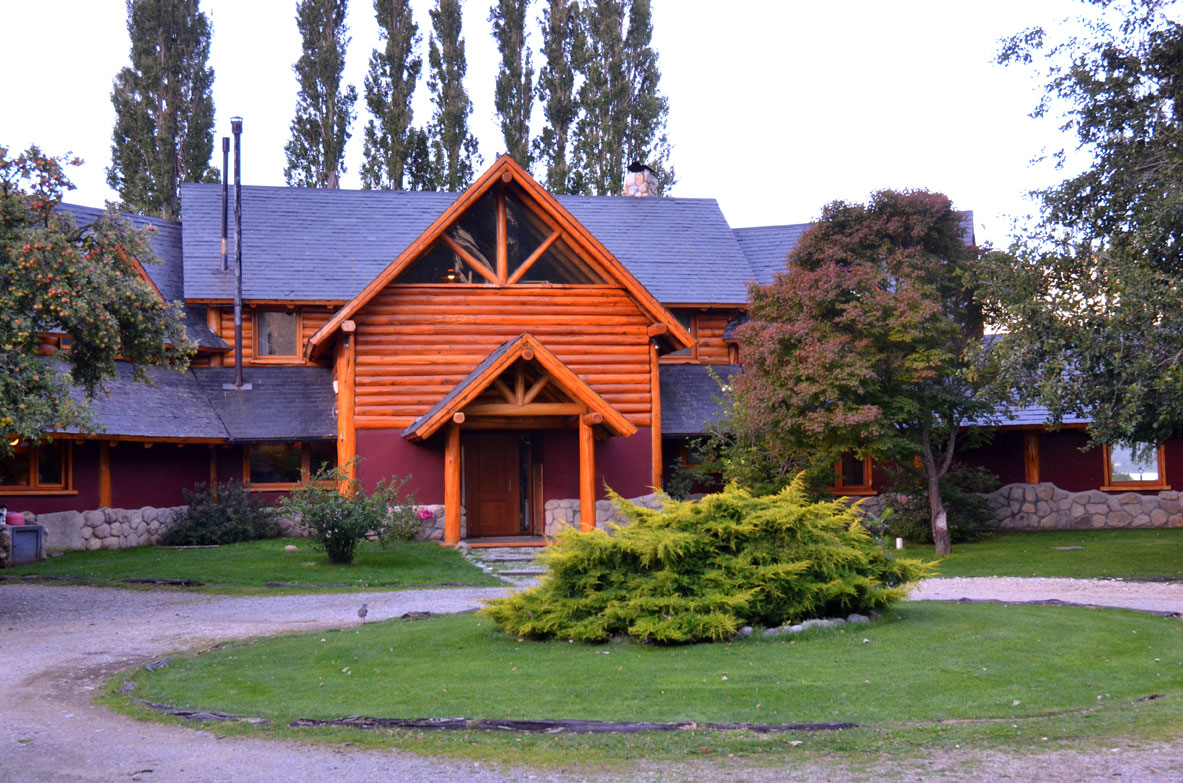
In Buenos Aires, we chose a less expensive strategy of renting an Airbnb apartment instead of a hotel. Our apartment was in the Palermo section, which twenty years ago was bohemian, but now is super trendy. It is walkable, full of tree-lined streets and has a slew of good restaurants and bars.
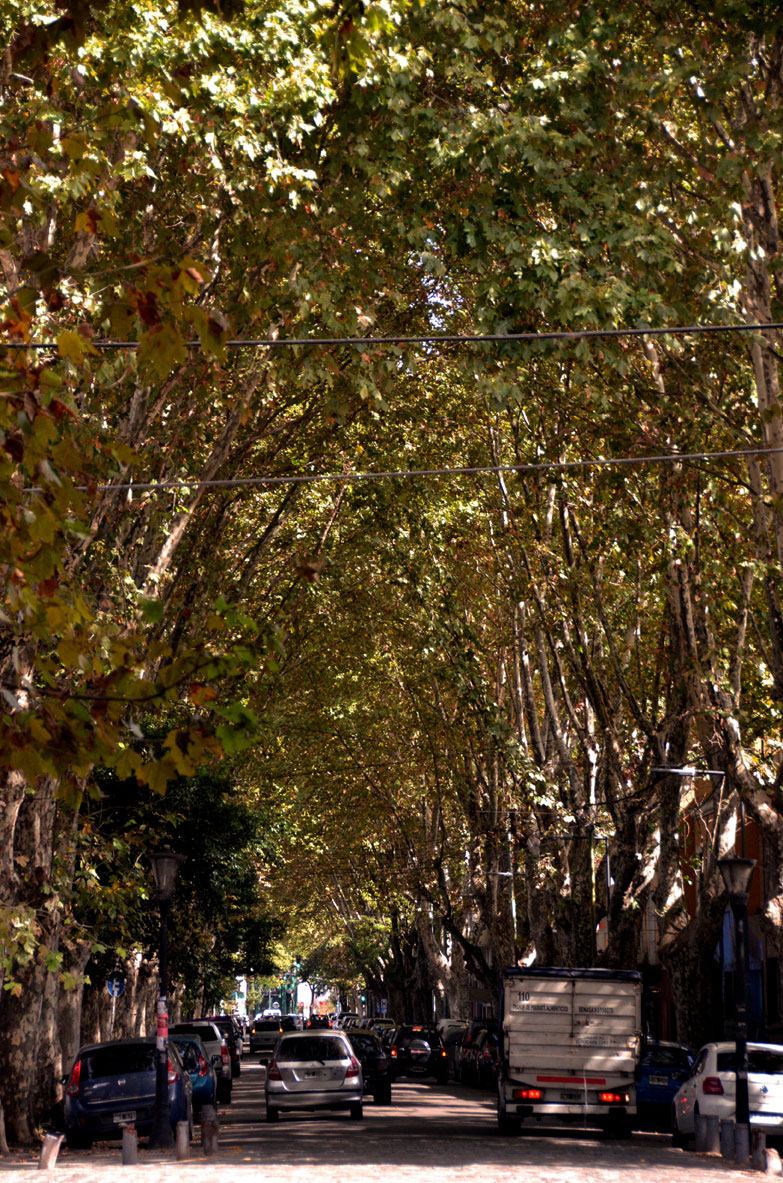
The cost was probably about half of a hotel, as we paid $677 for ten nights. The apartment had a small bedroom and living room with cable TV, good Wi-Fi, a balcony, a kitchen opening to the living room and a bathroom. In the apartment complex there was gym with equipment and free weights, a small outside pool and laundry machines. We loved that we could occasionally cook our own meals, especially breakfast, and have a fridge. It was fun going to the local vegetable markets and observing the pace of the local life.
Recently enacted, the value-added tax (VAT) of 21% is waived for foreign tourist. You will not be billed this amount if you pay with a foreign credit or debit card and give your passport number and home address. This is a significant savings, so be sure you receive it. As it is new, hotels are learning how to comply with the required paperwork. This does not apply to rentals through Airbnb and similar companies, as they do not collect VAT.
Restaurants
For a country that has economic challenges, it is not apparent in the full restaurants and bustling bars and clubs. We usually went out to restaurants around 8:30pm for dinner and were one of the first ones there. During the week most Argentines eat dinner after 9pm and the weekend as late as 11pm.
If you love a delicious and hearty portion of beef, this is the country for you. The restaurants featuring meat are called a parrilla (grill or steakhouse) or an asado (barbecue featuring ribs). Sometimes they have the animal prominently displayed on a large spit. From our experience, meat is served well-done unless you stress you want it rarer.
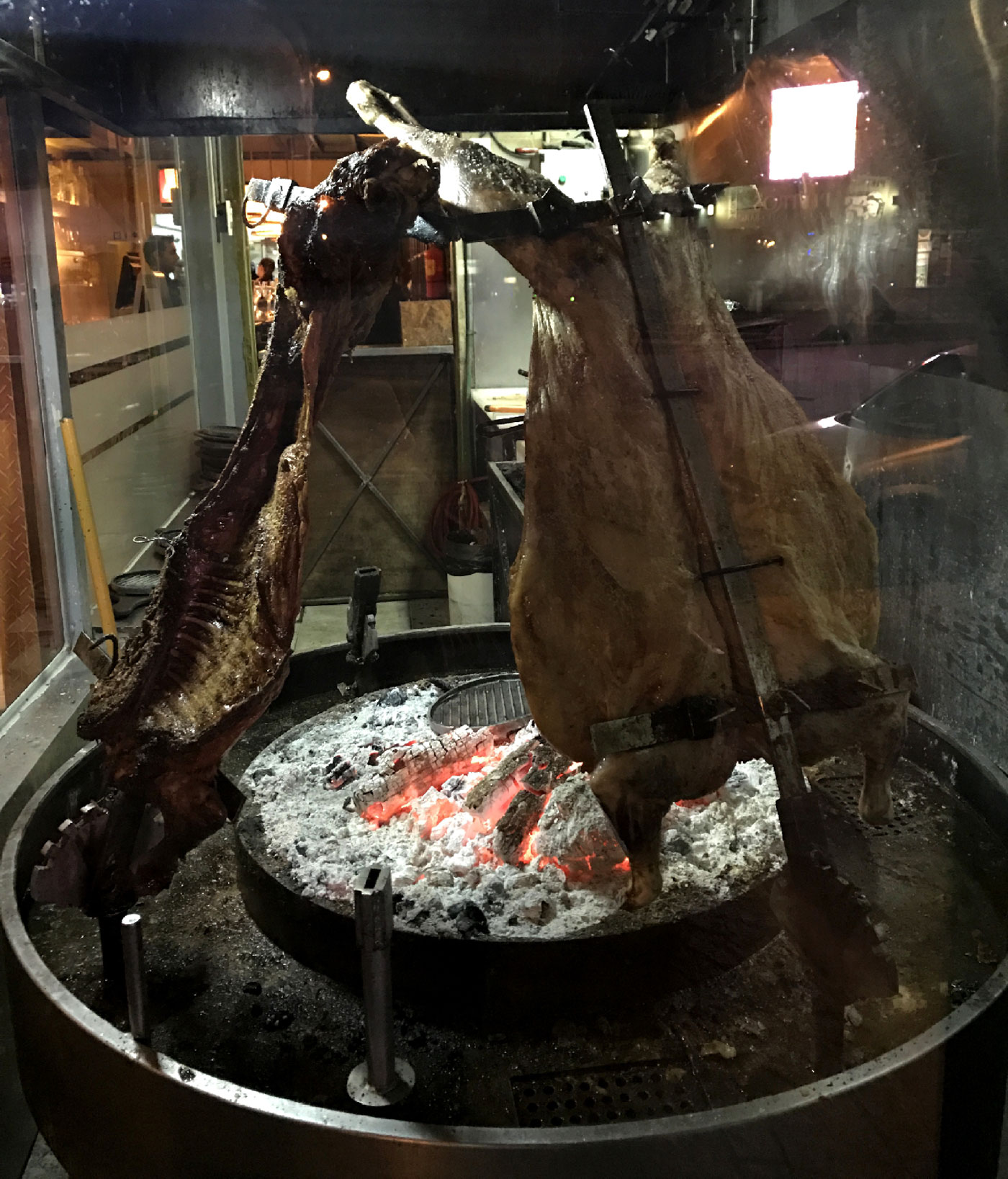
There are seemingly pizza or pasta restaurants on every block, no doubt because of the heavy Italian immigration over the years. There are also many cafes and small restaurants which serve minutas (small dishes for light lunches and snacks) including empanadas and sandwiches with thin bread.
Something that has been quite popular is puerta cerrada, which is a closed-door restaurant by reservation only, generally in the chef’s home. One afternoon, we emailed one for reservations, but no one responded.
Restaurants often have cubierto (service charge, literally meaning cutlery) added to the bill, ostensibly for bread and tap water, but it is just a way to make more money. In our experience, tips were not included in the bill. If not sure, as it is often not clear to a tourist, ask your server. The standard tip is 10% and paid in cash.
Internet and Phone
Internet access is widely available in Argentina. However, in estancias and national parks, internet comes from satellite and has limited band width and is not always available. You can use your phone for data and voice with a local SIM card or through a roaming plan from your home provider. You may also be able to buy a basic local phone.
Cell phone numbers in Argentina are always preceded by 15. If you’re calling a cell phone number from a landline, you’ll have to dial 1 first (add the area code before the 15 if necessary). However, if you’re calling a cell phone from another cell phone, you don’t need to dial 15. You don’t need to dial 15 to send text messages. Whatsapp is a popular way of sending free texts in Argentina, providing both parties have it installed. (This explanation is from Lonely Planet.)
Of course, you can always use Skype or Google Voice from your computer to make calls, if you have internet access.
Safety
According the US State Department: “Street crime in the larger cities (greater Buenos Aires, Rosario, Mendoza) is a constant problem for residents and visitors alike. Criminals are often well-dressed, and crime can occur anytime during the day at any location. Visitors to Buenos Aires and popular tourist destinations should be alert to muggers, pickpockets, scam artists, and purse-snatchers.” We were warned daily from friends, merchants and police to watch out for my camera.
We had no incident, nor saw anything. Only once did we get spooked in La Boca, where we went a block off the main street of El Caminito and there were a few young men observing us excessively. But after all the warnings, I usually left my Nikon SLR camera at home and used my IPhone for photography. When I did carry my camera bag, I slung it over my shoulder and neck with the bag on my chest. This is a good precaution for purses and bags.
History
It is helpful to understand at least a smattering of Argentinian history to understand the culture, economy and politics. It is so full of twists and turns, it is hard to distill, but here is an effort to do so.
The first human settlements are estimated to be about 13,000 years ago. Spanish exploration started in the early 1500s. For the next 300 years, Spain gradually colonized the area, although it was more interested in the gold from Bolivia and other countries. In 1776, Spain established the Viceroyalty of the Río de la Plata (River of Silver) for several territories in the northern part of current Argentina. There was an independence movement (partially led by Jose de San Martin), including the Revolution of May 1810, declaration of independence in 1816, and the military defeat of Spain in 1824. A federal state was formed by 1861, known today as the Republic of Argentina (land of silver).
Throughout the history, there has been rivalry between Buenos Aires, as the leading city, and the rest of the mainly rural country. In the 1830s and 1840s, the dictator Juan Manuel de Rosas subdued regional authoritarian leaders and established a strong federalist country dominated from Buenos Aires.
In 1853 Argentina adopted a constitution with a system of government similar to the United States, with a two-house congress, independent judiciary and a president elected via an electoral college (fortunately they eventually switched to a direct vote, unlike the US).
In the 1870s, Argentina conducted the “Conquest of the Desert” to establish its dominance over Patagonia, which was inhabited by Amerindians. The campaign was militarily successful and ended the possibility of Chilean expansion there. This conquest was and still is extremely controversial, being termed either as a spread of civilization or genocide.
Argentina became a regional economic powerhouse from 1880 to World War I, fueled by utilizing its vast land for beef and agriculture, sizable immigration from southern Europe (especially Spain and Italy) and investment (foremost from Britain). For a time, its GDP per capita was higher than many European countries and it rivaled the wealth and economic potential of the USA. The manifestation of this wealth is evident is the mansions, churches, parks, monuments and boulevards, built before and after the turn of the century and define Buenos Aires.
In 1916, the country held presidential elections under universal male suffrage and elected, for the time, a far-left government replacing the conservative forces which had dominated Argentine. Until 1930, this political movement, led by Hipólito Yrigoyen, enacted necessary reforms to maintain relative economic prosperity and some social reforms (e.g. minimum wage and right to strike); albeit there were continual demonstrations and general strikes for more changes (sometimes violently repressed). During this time, right wing paramilitary organizations formed to resist. On September 6, 1930, a military coup overthrew the Yrigoyen’s government and began a period in Argentine history known as the Infamous Decade. A provisional regime was established and then a series of unstable civilian governments elected in fraudulent election, starting in 1932. In this decade, the military and certain business leaders veered towards fascism and part of the opposition towards communism, creating an unavoidable clash.
In 1946, Juan Peron, won the presidential elections with a majority vote. His philosophy is hard to define but included state-guided capitalism (privatizing many companies), economic nationalism (buying out foreign interests in the Argentine economy), social programs for the lower classes, isolationism in foreign affairs and making the government the arbiter of disputes. His second wife, Evita, was extremely popular with the public, but died from cancer in 1952 at the age of 33. Peron won three elections (two in a row, one much later) and built a cult of personality. However, the military always viewed him warily and finally ousted him in a 1955 coup after rising inflation, unfunded expansion of social programs and increasing authoritarianism. Afterwards there were frequent military coups between mostly ineffective civilian governments (including the return of Peron in 1972, who died in 1973)
From 1974 to 1983, Argentina experienced the “Dirty War” during which military and security forces and right-wing death squads killed left-wing guerrillas and other “subversives”. Over 10,000 people were killed and up to 10,000 “disappeared”. After a disastrous war with Britain over the Falkland Islands and massive protests and marches of mothers with missing children at the Plaza de Mayo in Buenos Aires, civilian rule was restored.
Towards the end of 2001, the Argentina economy had huge foreign debt and high inflation, which significantly affected the income and wealth of most of the population. Argentina struck a deal with foreign creditors and by 2003, there was noticeable economic improvement. On November 22, 2015, Mauricio Macri, a right of center politician won the presidency, replacing 12 years of left of center Presidents, first by Nestor Kirchner, then his wife Cristina. Macri is the son of Franco Macri, an Italian-born tycoon and head of one of Argentina’s leading corporate conglomerates. He was also president of Boca Juniors Football Club, one of the most popular soccer teams in the country.
The Macri government is reducing financial regulations to encourage investments and tourism. It is also working to reduce the rate of inflation. There is hope that reforms will spur economic growth in 2017 and 2018 and reduce unemployment from its current rate of 7.6% in January 2017.
(Note: the above was derived from several on-line sources, including Wikipedia, several newspapers and a good report on http://www.international-relations.com/WbLatinAmerica/Lec9.htm.)
Travel Guide
I am a fan of Rough Guide, especially for the independent traveler. Many other guides concentrate on glossy pictures and top ten lists. Rough Guides give detailed information on almost everything we encountered.
BUENOS AIRES
After a three-hour flight from El Calafate, we arrived at night in Buenos Aires and took a cab to our Airbnb apartment in Palermo. It was late for us, after 9pm. We went to a nearby sushi restaurant and found it full, then we remembered everyone ate late here.
Argentina was wealthy around the turn of the 20th century. At that time, there was massive investment in Buenos Aires building mansions, attractive apartments, churches, monuments, wide boulevards, expansive parks and numerous tree-lined streets.
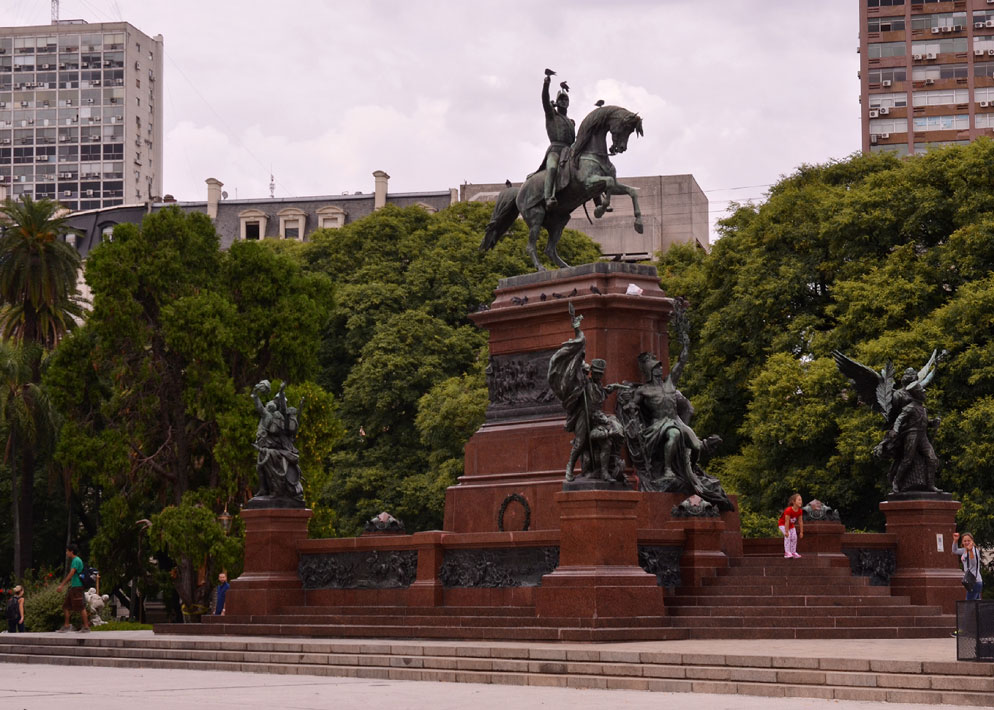
Throughout its history, Buenos Aires has constantly built residences and offices, some very creative, other mundane, as zoning does not appear to enforce uniformity. Often people say it reminds them of Paris or Barcelona. In Buenos Aires, an architect is one of the most common professions (the other is a therapist). We spent a full week in Buenos Aires. It is such a fun place, with endless good restaurants and a lively night life.
To get oriented we took a three-hour donation-only tour with Martin Wasserman,
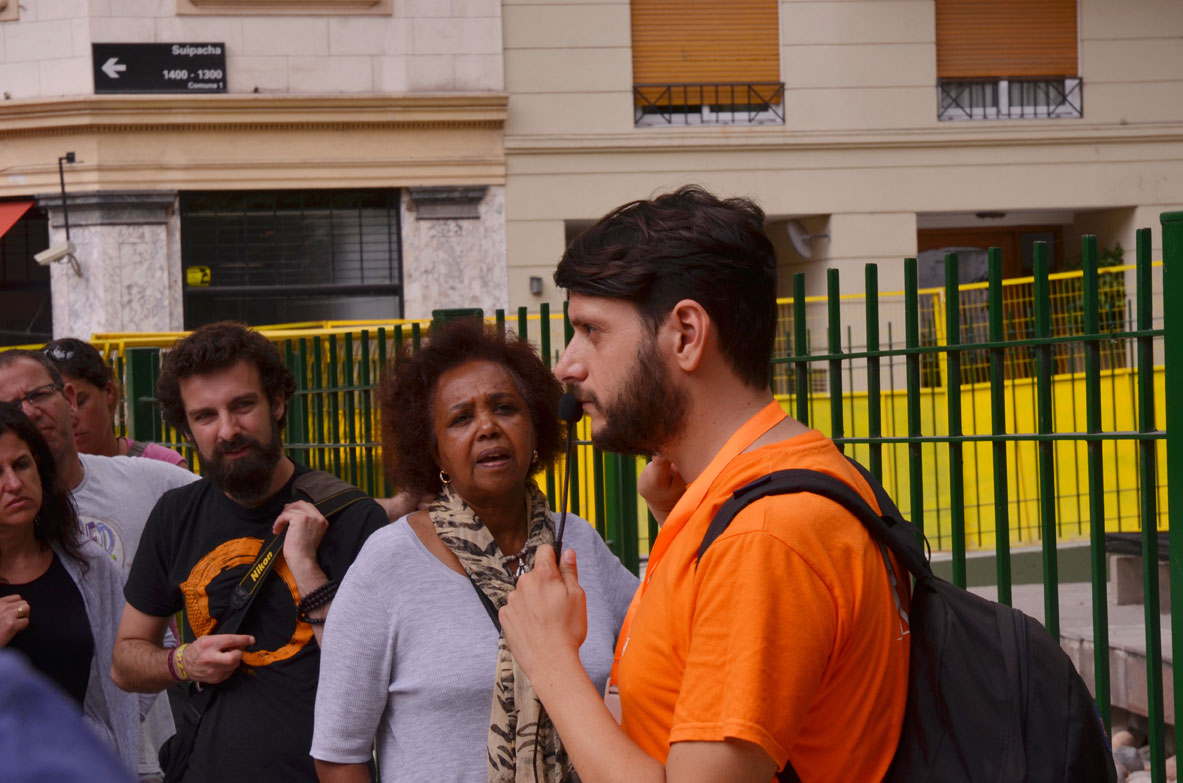
meeting by the Obelisk; the city’s most common point of reference, at the nearby Colon Theater.
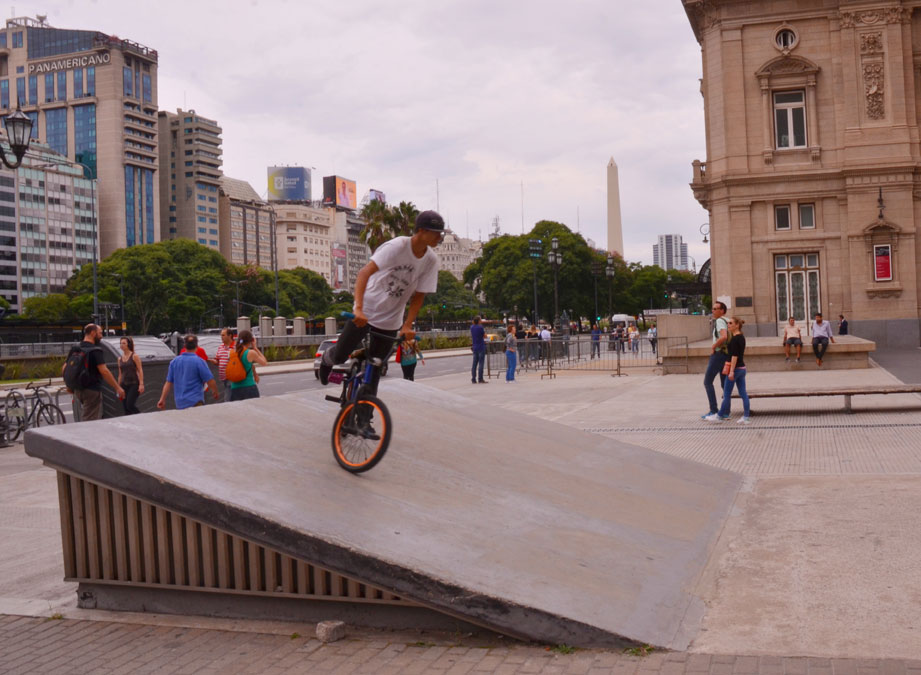
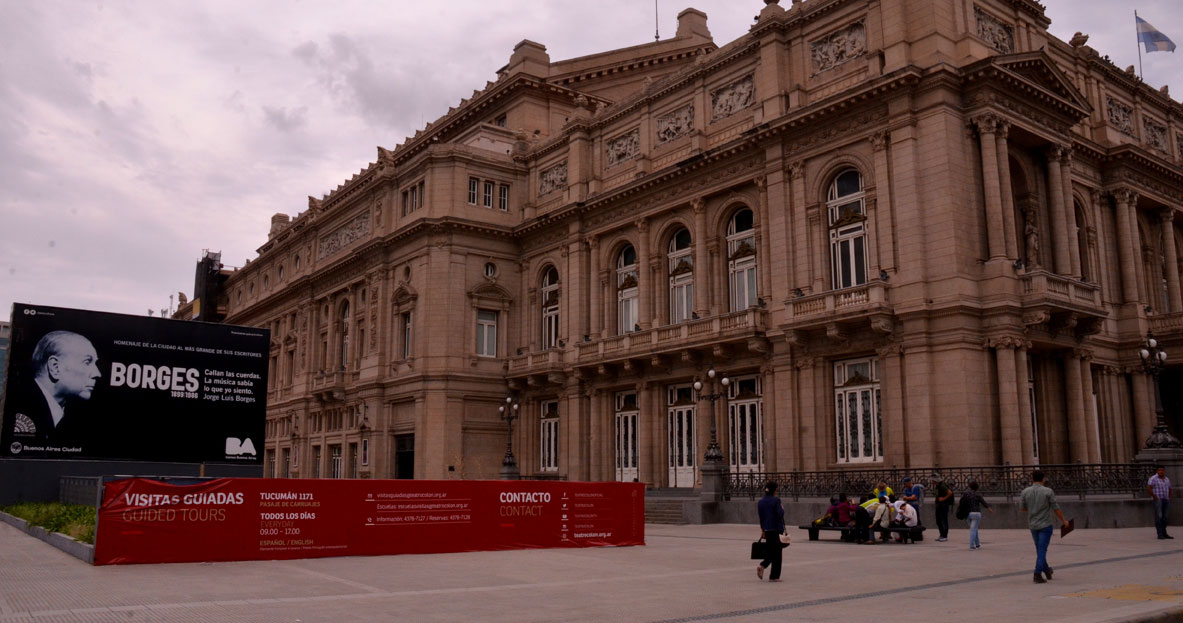
He was a fount of knowledge on the history, architecture and politics of the city. You can find free tours online! Our tour ended in the Recoleta Cemetery, which you could spend three hours visiting, marveling at the artistic structures and stories of the inhabitants; the most famous is Evita Peron.

We ate mainly in the Palermo area, within walking distance of our apartment. Not being big meat eaters, we proved you could eat very well outside of parrillas. Recommended restaurants are: Artemisia Cocina Natural (vegetarian and fish), Bio (vegetarian and organic) and Cucina Paradiso (expertly cooked Italian). Tufic is a great place for Argentine ice cream, similar to Italian gelato.
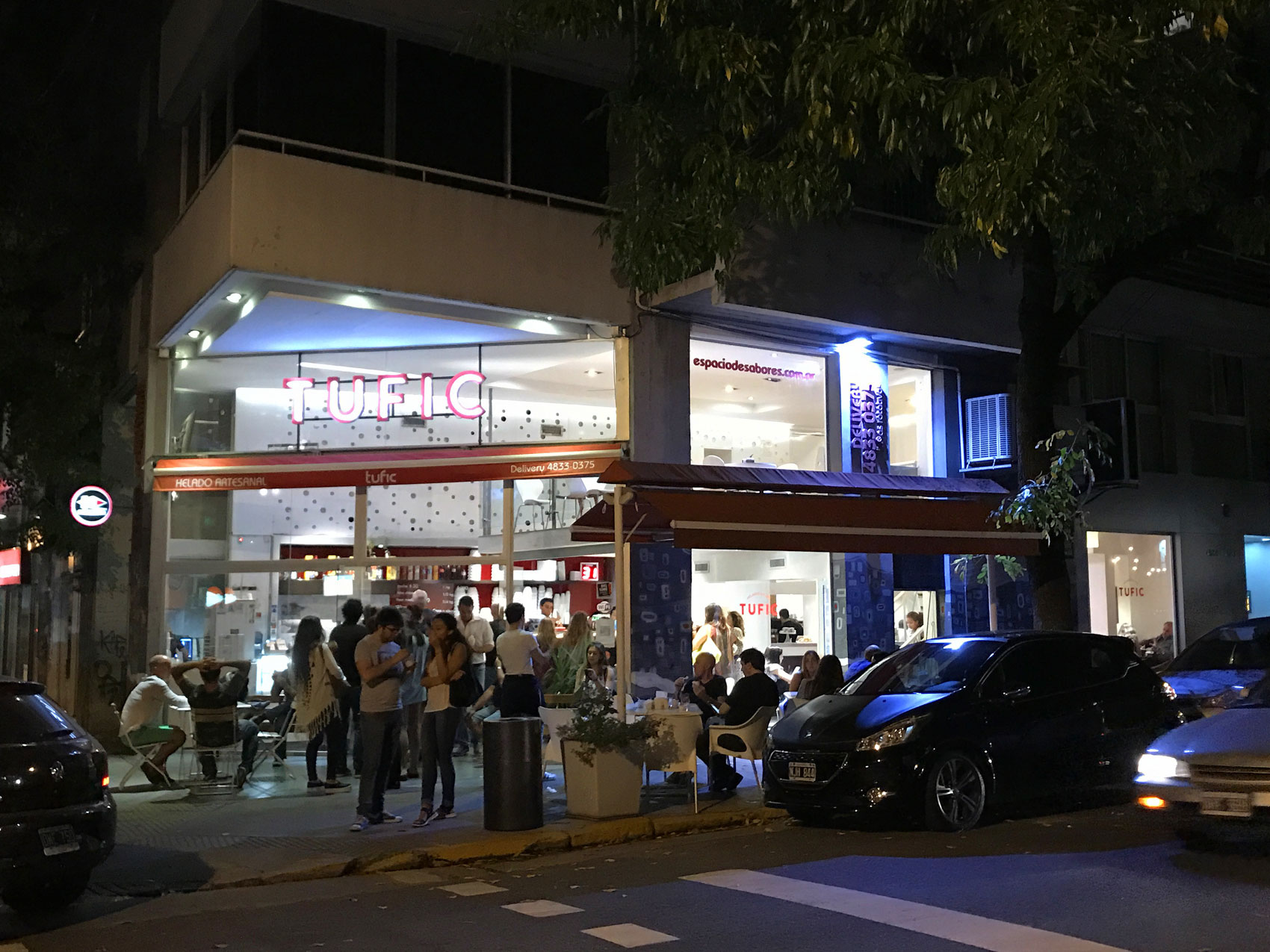
Palermo is full of young people. There are many apartments popping up with large windows and balconies among the one to three story houses that have been there for last fifty to hundred years. It reminds me of Williamsburg in Brooklyn, but much bigger and not as much of a youth ghetto and hipster center.
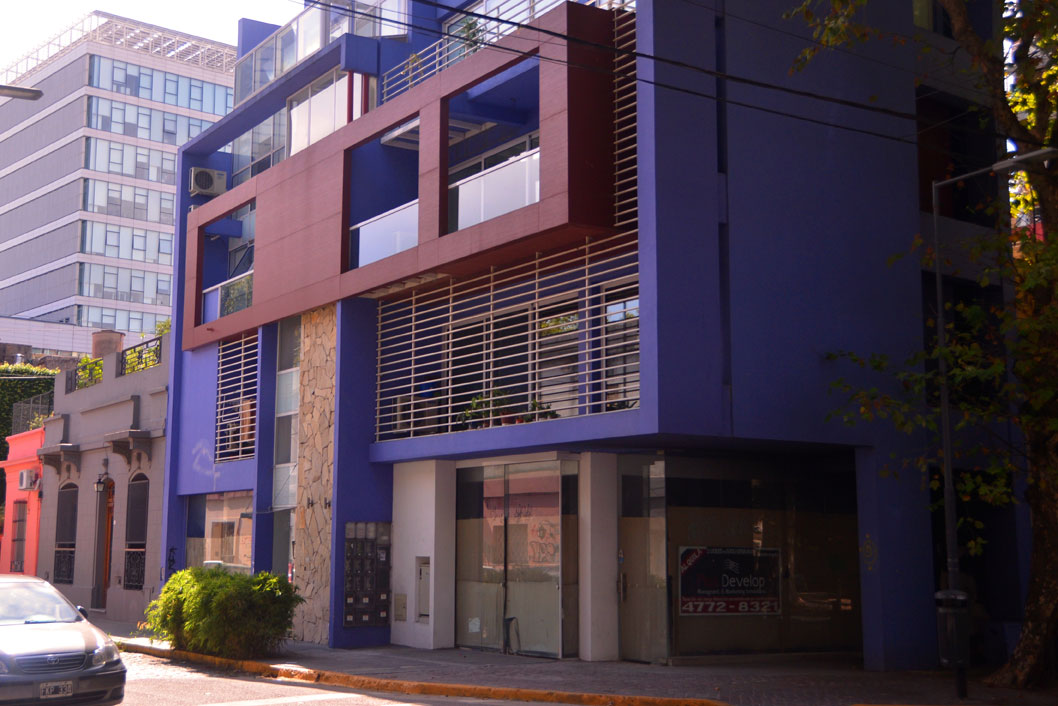
We went to one museum, The National Museum of Fine Arts (Museo Nacional de Belles Artes). Not spending much time in any one gallery, we walked through the whole place in an hour. It has a smattering of European art from medieval to impressionism. We focused on the Argentinian painters. One we liked a lot, with his own gallery, is Antonio Berni (1905–1981), whose work included surrealist biblical scenes.

We took the subway to the end of the C line and discovered an architectural gem: the Constitution railway station.
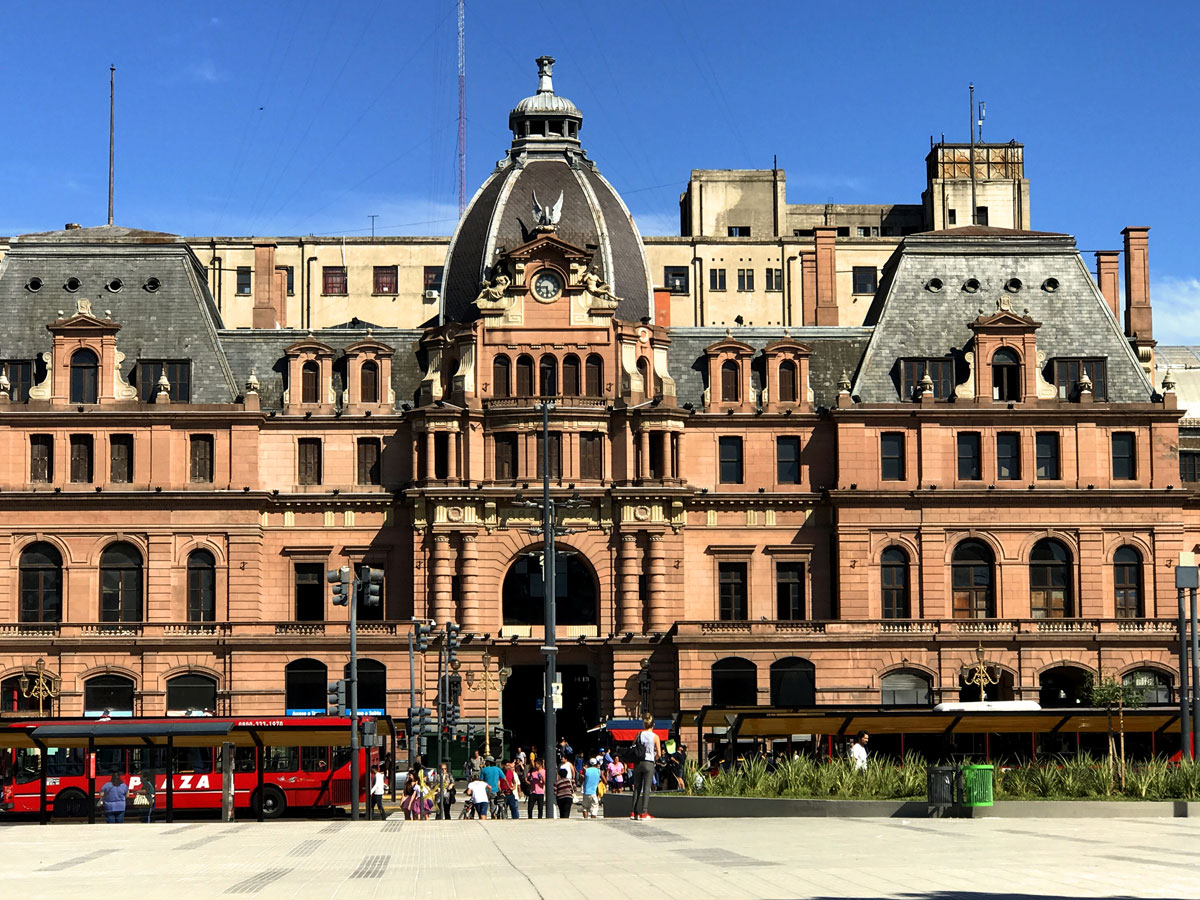
From there we walked maybe a mile to Lezama Park, which is one end of a large antique market in San Telmo on Sunday. Then we walked to La Boca, past the La Bombonera (cozy space) stadium, home to the very popular Boca Juniors soccer team. We saw vans of police on the road preparing for the game later. We ended up on Caminito Street, with many buildings painted in colorful rectangles, next to a harbor with many giant cranes.

We sat in an outdoor café and watched tango dancing, a couple at a time.
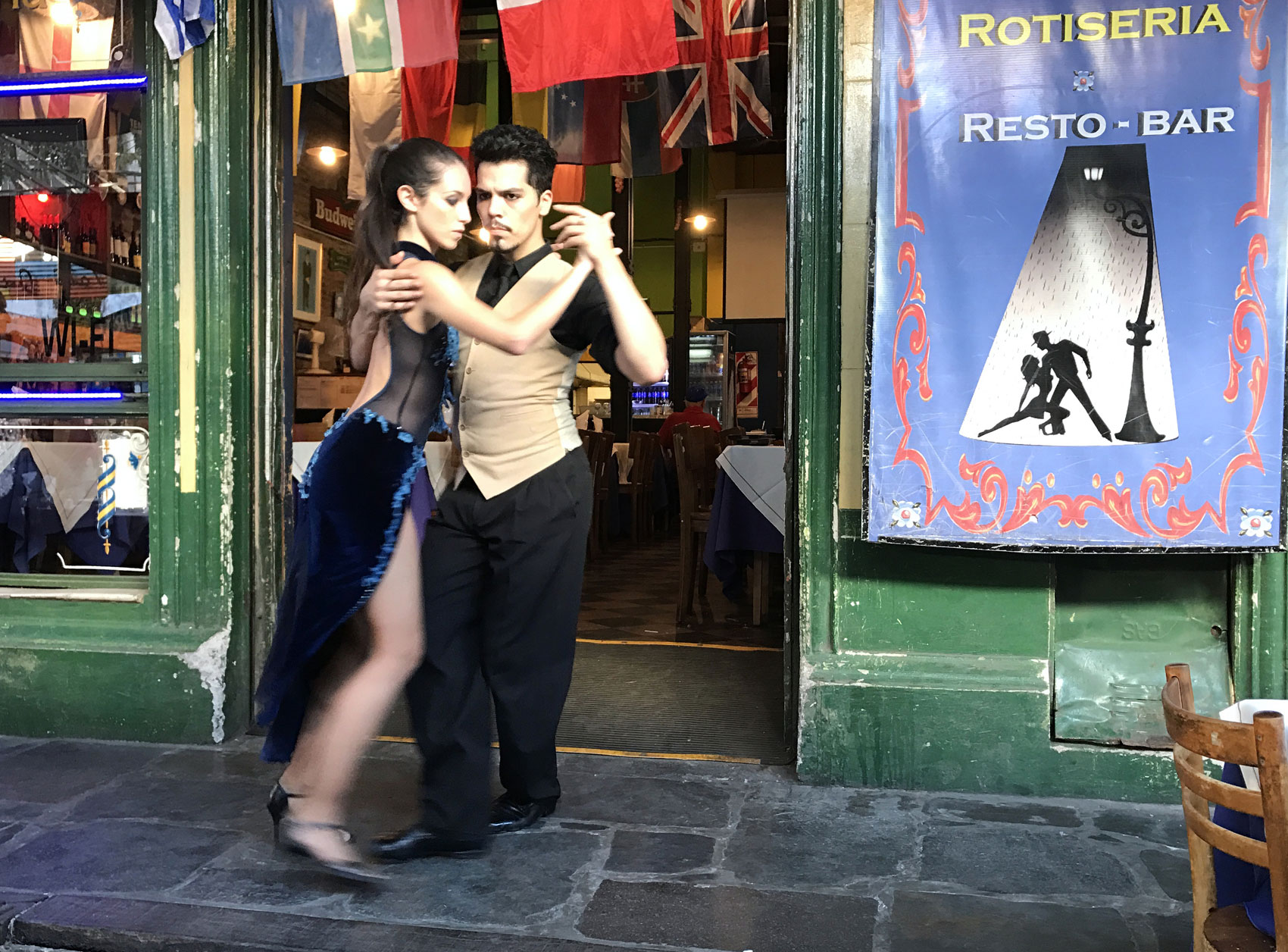
After walking so much, probably well over three miles, we took a cab to Palermo. It was our most expensive cab ride not going to the airport, at A$300 ($18), as it took 45 minutes through moderate traffic.
One night, because we were in the general area, we had dinner in Puerto Madero, which is a concentration of residential and office skyscrapers. A few buildings would fit in the futuristic skyline of Shanghai. There is a long promenade utilized by both joggers and pedestrians, next to an inlet which has an asymmetrical, cantilever-looking rotating bridge (Women’s Bridge). This district reminded me of Battery Park / World Financial Center in lower Manhattan.

I needed some camera accessories and found five stores in central Buenos Aires. My favorite name was P&H Photo, a knockoff of B&H Photo in New York. Following a friend’s recommendation, we went to Silvia and Mario (Marcelo T. de Alvear 550), a friendly, family-run leather store. The service was excellent, though intense. They have a wide selection and can alter or make a jacket in a day. We ended up buying one leather jacket, two belts and two wallets for about $300, maybe 60% of the cost in New York. The jacket had to be altered and they delivered it to our apartment.
I was surprised by the music of Argentina. In one of my first taxi rides, the radio was blasting a song by Jack White’s The Dead Weather group. I learned that alternative rock is popular in Argentina and has a long history. Flying back to New York, I listened to Los Fabulosos Cadillacs, a group I had only heard the name of. Their latest release is La Salvación de Solo y Juan, which is some of the best rock I have heard in the last few years.
Colonia del Sacramento (Uruguay)
Colonia del Sacramento’s historic quarter is a UNESCO World Heritage site. It was founded by the Portuguese in 1680. It is a desirable destination if you want a relaxing day. We took the Buquebus ferry, round trip fare about $100 person (could be lower on other days and seasons), which left from Puerto Madero at 8:15am and returned 4:15pm. You need to arrive an hour ahead of time to buy a ticket, go through immigration and board. The ride is about one hour and fifteen minutes. No need for Uruguay currency, everywhere accepts the Argentina peso.
Once there, we found the historic quarters to be small. Going through every building exhibit and walking every street would take no longer than two hours.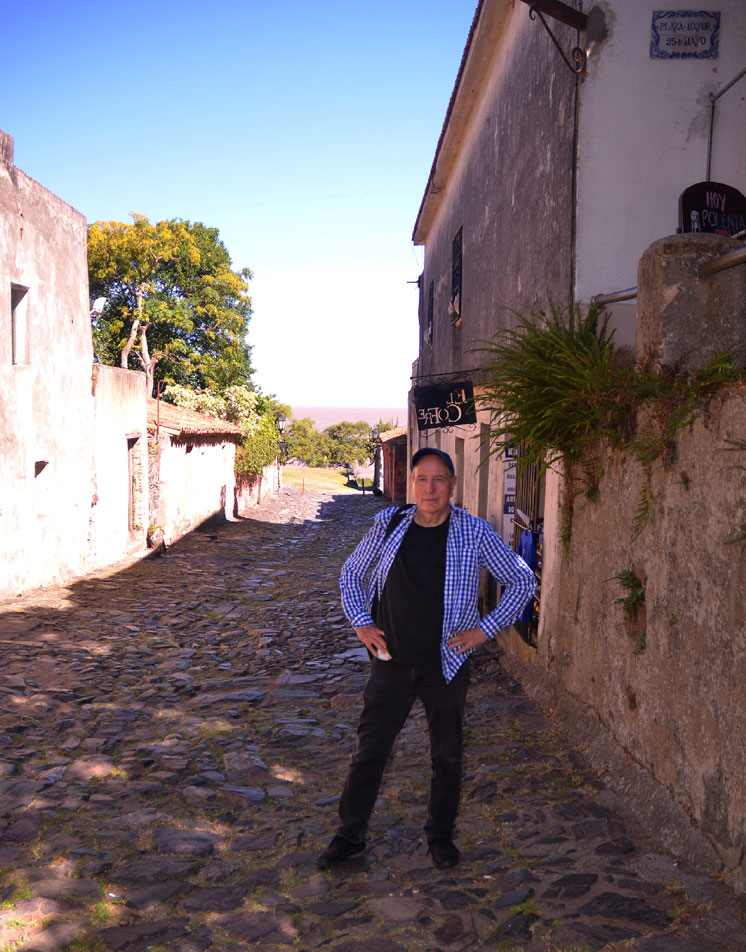 ..
..
While Colonia is interesting, I could not help but compare it to Trinidad, Cuba; where I visited recently and, for what it is worth, I found more impressive. The area consists of old stone buildings, a lighthouse and some remnants of fortified walls. While walking around, I saw interesting vehicles parked in picturesque settings. They included a hippie VW bus, antique 1930s cars, old pickup trucks and 1950s classic cars you find everywhere in Cuba.

I soon realized that the city placed these strategically in the old town, apparently to make it more charming, even though they did not have any connection to the place. They must have been thinking about the Instagram market. This contrivance really turned me off.

